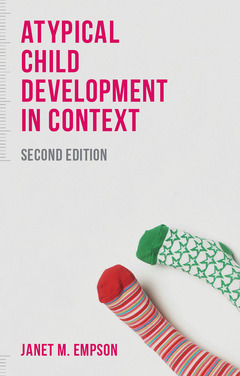Description
Atypical Child Development in Context (2nd Ed., 2nd ed. 2015)
Author: Empson Janet
Language: English
Subject for Atypical Child Development in Context:
Publication date: 09-2015
Support: Print on demand
Withdrawn from sale
Support: Print on demand
Withdrawn from sale
Description
/li>Contents
/li>Biography
/li>Comment
/li>
Have you ever considered what atypical development looks like in practice? Or how it occurs? Would you like to know which children are most at risk and why?
In this new and fully updated edition, Janet M. Empson explores what is 'normal' and what is 'atypical' or 'unusual' in children's development. Combining key research with insightful case studies and examples, she examines the processes, circumstances, and conditions associated with developing atypically. This is invaluable reading for both students and professionals involved in child development.
1. Typical and Atypical in Child Development.- 2. Risk and Resilience and Atypical Child Development.- 3. Child Abuse.- 4. Emotional and Behavioural Difficulties: Internalising and Externalising Disorders.- 5. Genetic and Pervasive Developmental Disorders.- 6. Learning Disability.- 7. Approaches to Intervention.- 8. Atypical Child Development and Social Issues.
Dr. Janet Empson is currently Visiting Fellow to the Faculty of Development and Society at Sheffield Hallam University following a career of nearly thirty years of research and lecturing in developmental psychology at various universities in the UK. She has held the positions of Research Fellow on a project on transmitted deprivation at the University of Hull, and Principal Lecturer and Head of Psychology at Sheffield Hallam University. She has contributed chapters to a number of books and has written two textbooks on child development.
The book considers the important issue of what is 'normal' and what is 'atypical' in child development. It examines the main processes involved in developing atypically, as well as the circumstances and conditions associated with it. The second edition is fully updated and features new research, case studies, real life examples and figures.
© 2024 LAVOISIER S.A.S.
These books may interest you

Aphasia in Atypical Populations 64.97 €



